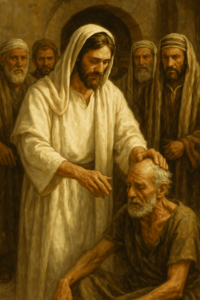The concept of the “Sabbath day journey” is an element of biblical and Jewish law that bridges theological, historical, and cultural dimensions.
Rooted in ancient Israelite practice and later codified in rabbinic literature, this principle restricted travel on the Sabbath to preserve its sanctity as a day of rest.
This article examines the Sabbath day journey’s origins, biblical foundations, rabbinic interpretations, and theological implications.
Definition and Origin of the Sabbath Day Journey
Terminology and Basic Concept
A “Sabbath day’s journey” (Greek: *σάββατον ὅδον*, *sabbatou hodon*) refers to the maximum distance one was permitted to travel on the Sabbath under Jewish law.
The term appears explicitly in Acts 1:12, where the disciples return to Jerusalem from the Mount of Olives after Jesus’ ascension, a distance described as “a Sabbath day’s journey.”
Rabbinic sources, such as the Mishnah (Eruvin 4:3), quantify this distance as 2,000 cubits (approximately 3,000 feet or 0.91 kilometers).
Biblical Foundations
The practice is considered to originate from two key Old Testament passages:
Exodus 16:29: God commands the Israelites to remain in their place on the Sabbath, refraining from gathering manna. This injunction underscores the Sabbath as a day of physical and spiritual rest.
However, we do not find any details, it only says: “let no man go out of his place on the seventh day.”
Numbers 35:5: Levitical cities are allotted pasturelands extending 2,000 cubits from the city walls. While not directly about the Sabbath, this measurement later informed rabbinic interpretations of permissible travel limits.
Rabbinic Interpretations and Expansions
The Techum Shabbat
The Talmudic concept of techum Shabbat (“Sabbath boundary”) formalized the 2,000-cubit limit.
Rabbis derived this distance from the Israelite camp’s layout in the wilderness (Numbers 35:5), where the Tabernacle stood at the center, surrounded by a 2,000-cubit radius for Levitical pasturelands. This boundary was metaphorically applied to Sabbath travel.
The Eruv: Extending the Boundary
To accommodate practical needs, rabbis devised the eruv (Hebrew: עירוב, “mixture”), a symbolic enclosure that allowed Jews to extend the Sabbath boundary by linking private domains.
By marking an area with posts or wires, communities could effectively “reside” in a shared space, permitting movement beyond 2,000 cubits.
The tractate Eruvin in the Talmud details these legal intricacies.
Exceptions and Flexibility
Certain exceptions relaxed the restrictions:
– A “four cubits” allowance for urgent needs (Mishnah Eruvin 4:1).
– Travel for religious purposes, such as attending synagogue services.
New Testament Context and Implications
Acts 1:12 and the Early Church
After Jesus’ ascension, the disciples’ return from the Mount of Olives to Jerusalem is noted as “a Sabbath day’s journey” (Acts 1:12).
Jesus and Sabbath Controversies
Jesus’ ministry often clashed with Pharisaic interpretations of the Sabbath law.
For instance, healing on the Sabbath (e.g., Luke 13:10–17) prioritized compassion over legalism, challenging rigid adherence to rules like the techum.
His actions underscored the Sabbath’s purpose as a gift for human well-being (Mark 2:27).
Theological and Symbolic Dimensions
Spiritual Rest and Trust in God
The 2,000-cubit limit symbolized reliance on divine provision, echoing Exodus 16’s manna narrative. By restricting labor and travel, the Sabbath fostered trust in God’s sustenance.
Historical and Cultural Context
Archaeological Evidence
Remnants of eruvin have been found in ancient Jewish communities, illustrating the practice’s historical prevalence. For example, stone markers near Usha in Israel delineated Sabbath boundaries.
Modern Observance and Legacy
Contemporary Jewish Practice
Orthodox Jews still observe techum Shabbat, using eruvin in cities worldwide. In New York, a wire eruv encloses Manhattan, enabling adherents to carry items outdoors on the Sabbath.
Christian Perspectives
While Christians do not observe Sabbath travel limits, the concept informs discussions about Sabbath-keeping as spiritual rest.
Conclusion
The Sabbath day journey reflects the dynamic interplay between law and grace, tradition and innovation.
God does not want us to have this sort of strict laws like the Jewish leaders have made.
They have extended to 39 rules of the Sabbath. The problem is we do not find any of this in the Bible.
God told us to do no work and rest on the seventh day. (Exodus 20:8-11)
It would be a burden to carry a list with 39 rules on the Sabbath and see what is allowed and what is not.
That would not be a day of rest anymore.
The moral is to leave aside all these man made rules – like to travel no more than X miles or whatever on the Sabbath.
Instead, we should follow God’s principle and do no work on His holy day.
Traveling is not appropriate anyway on the holy day of God. Only if travelling is done for the purpose of worshipping with others.
References
– The Holy Bible KJV
– Mishnah and Talmud (Tractate Eruvin).
– Josephus, Antiquities of the Jews.
– Philo, Life of Moses.
– Safrai, S., The Jewish People in the First Century.
My Letter To A Sunday Keeper – Sabbath Documentary

The Days of Noah – Powerful Documentary (Video Format)

Bible Studies – Written Format







